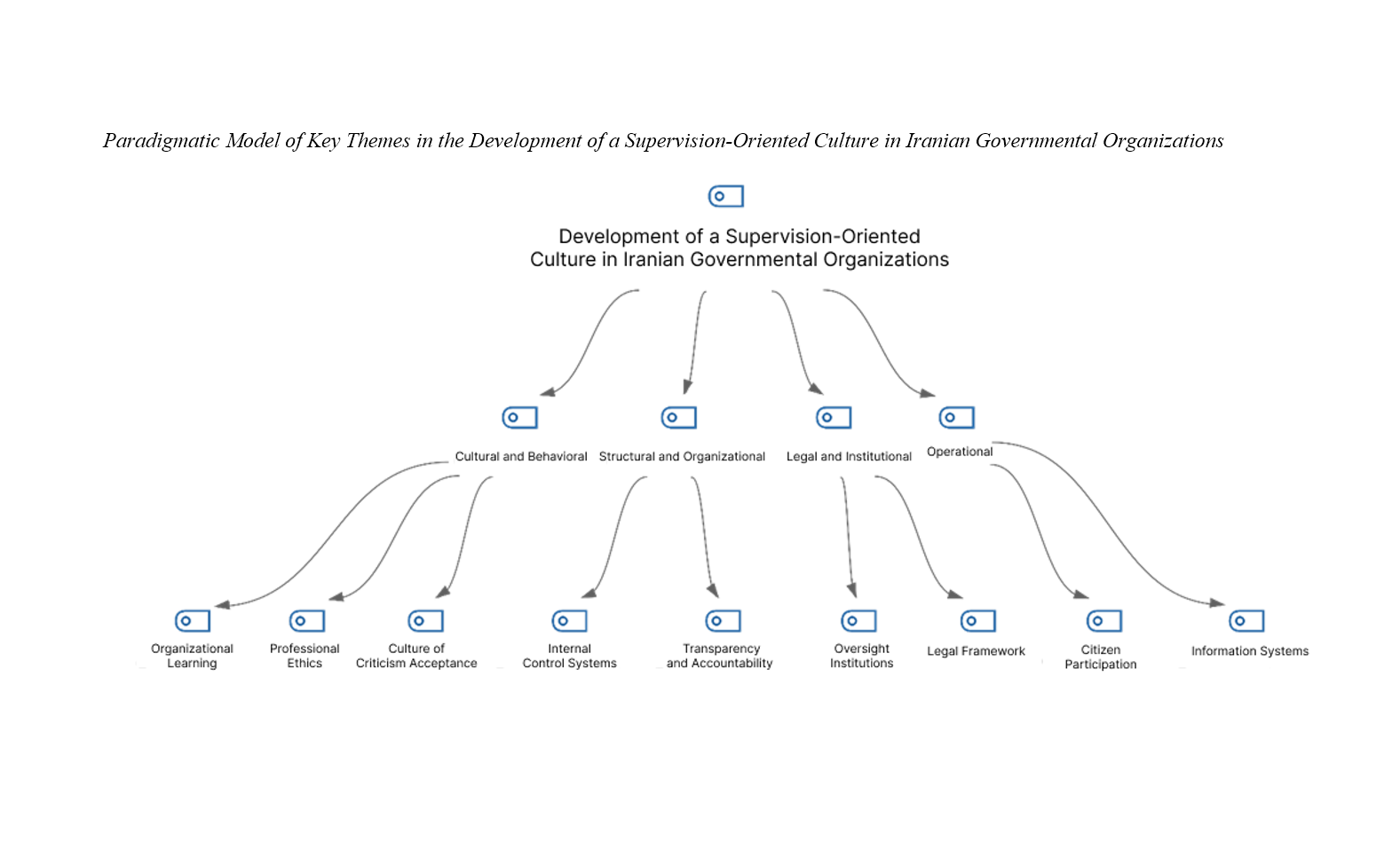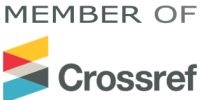Qualitative Thematic Analysis of Key Dimensions in the Development of a Supervision-Oriented Culture: A Study in Iranian Governmental Organizations
Keywords:
supervision-oriented culture, transparency, accountability, governmental organizations, localized managementAbstract
This study aimed to develop a qualitative model of a supervision-oriented culture with an emphasis on transparency, accountability, and responsibility within Iranian governmental organizations. The research employed a qualitative methodology based on thematic analysis. The statistical population included experts familiar with the subject matter, including senior and middle-level government managers, public administration and human resource management specialists, academic researchers in public administration and organizational behavior, and policymakers in the field of civil service laws. Participants were selected using purposive and snowball sampling methods. Inclusion criteria required a minimum of 10 years of managerial experience or at least 5 years of relevant research background, along with deep familiarity with the bureaucratic and cultural challenges in Iranian public sector organizations. A total of 20 semi-structured interviews were conducted, with an average duration of 65 minutes, continuing until theoretical saturation was achieved. Data were recorded and documented with written consent from the participants. Data analysis was performed using MAXQDA 2020 software through three stages: open coding, axial coding, and selective coding. In the initial stage, 274 semantic units were extracted, reduced to 54 initial codes, then categorized into 9 sub-themes, and finally synthesized into 4 main themes: structural and organizational (transparency and accountability, internal control systems), cultural and behavioral (criticism acceptance, professional ethics, organizational learning), legal and institutional (legal framework, oversight institutions), and operational (information systems, citizen participation). The validity of the findings was assessed using credibility, transferability, confirmability, and dependability criteria, with an average coding reliability reported at 84.78%. By identifying the key dimensions of a supervision-oriented culture and elucidating its barriers and facilitators in the Iranian context, this study proposes a localized framework for enhancing transparency, reducing corruption, and building public trust. The proposed model may serve as a tool for policymaking, improving the management of public resources, and strengthening good governance in Iranian governmental organizations.
References
Andrews, R., & Boyne, G. A. (2022). Task Priorities and Organizational Performance: The Effects of Target Clarity, Managerial Autonomy, and Publicness. Public Administration Review, 82(4), 616-631. https://www.cell.com/heliyon/fulltext/S2405-8440(23)02750-0
Boxall, P., & Purcell, J. (2022). Strategy and human resource management. Bloomsbury Publishing. https://doi.org/10.1093/oxfordhb/9780198749790.013.24
Burgess, S., Propper, C., Ratto, M., Tominey, E., & Schazenbach, H. (2020). Incentives in the Public Sector: Evidence from a Government Agency. The Economic Journal, 130(634), 359-377. https://academic.oup.com/ej/article-abstract/127/605/F117/5069467
Elemes, A., & Filip, A. (2022). Financial reporting quality and private firms' access to trade credit capital. The International Journal of Accounting, 57(02). https://doi.org/10.1142/S109440602250010X
Firouzyar, S., & KiaKojouri, D. (2013). Identification of Structural Restricting and Driving Factors of Development of Corporate Entrepreneurship (CE): A Case Study. Journal of Entrepreneurship and Innovation Management, 2IS - 3, 1-16. https://dergipark.org.tr/en/pub/jeim/issue/52619/692670
Golrokh, S. E., Verijkazemi, R., & Kia Kojouri, D. (2025). Developing a Qualitative Model of Responsibility Culture with a Blame-Free Management Approach in Iranian Governmental Organizations. Digital Transformation and Administration Innovation, 3(2), 1-13. https://journaldtai.com/index.php/jdtai/article/view/132
Grimmelikhuijsen, S., Porumbescu, G., Hong, B., & Im, T. (2013). The effect of transparency on trust in government: A cross‐national comparative experiment. Public Administration Review, 73(4), 575-586. https://doi.org/10.1111/puar.12047
Houston, D. J., & Harding, L. (2013). Public trust in government administrators: Explaining citizen perceptions of trustworthiness and competence. Public IntegrityVL - 16(1), 53-76. https://doi.org/10.2753/PIN1099-9922160103
Jeong, G., & Yoon, J. (2022). Organizational Performance and Administrative Corruption: Evidence from the U.S. Federal Government. Public Integrity, 1-17ER -. https://www.academia.edu/download/45459649/corruption.pdf
Julie, A., & Schneider. (2022). Rules with Compliance Built In. https://doi.org/10.1093/oso/9780197656747.003.0002
Kanyamuna, V., Kotzé, D. A., & Phiri, M. (2019). Monitoring and Evaluation Systems: The Missing Strand in the African Transformational Development Agenda. World Journal of Social Sciences and Humanities, 5(3), 160-175. https://www.researchgate.net/
Katz, D., & Kahn, R. (2015). The social psychology of organizations. Routledge. https://www.taylorfrancis.com/
Kiakojouri, D. (2024). Analysis of the relationships among Organizational Culture Indicators Using the DEMATEL Method at the Islamic Azad University in the West of Mazandaran Province. Journal of Dynamic Management Business Analysis, 2(4), 1-12. https://doi.org/10.61838/dmbaj.2.4.1
Kim, S., & Kim, M. (2017). National culture and social desirability bias in measuring public service motivation. Administration & society, 49(4), 444-476. https://doi.org/10.1177/0095399713498749
Leisink, P. L., Knies, E., & van Loon, N. (2021). Red tape and public service motivation: A study on goal displacement. Public Management Review, 23(6), 859EP - 878. https://journals.sagepub.com/doi/abs/10.1177/0734371X13511646
Ma, L., & Wu, J. (2019). How city managers' leadership styles influence public employees' public service motivation: The mediating effect of work meaningfulness. Public Personnel Management, 48(3), 371-389. https://onlinelibrary.wiley.com/doi/abs/10.1111/puar.12138
Mahdavi, E., Salajegheh, S., Pourkiani, M., Sayyadi, S., & Arabpour, A. (2023). Presenting an evaluation and monitoring model for institutional policies in the Islamic Republic of Iran in the field of resistance economy. Journal of Training and Improvement of Human Resources, 10(10SP - 1), 17. https://www.researchgate.net/prof
Matei, A., & Matei, L. (2018). Improving transparency and accountability in the public sector in the information era. Theoretical and Applied Economics, 25(4), 61-70. https://pari.org.za/
MirTaghian Rudsari, M., & Kiakojouri, D. (2016). Students' Attitudes to the Effectiveness of the Factors Affecting the Development of E-Learning (Case Study: Imam Khomeini Marine Science University in Nowshahr). Journal of Teaching in Marine Science, 3(5), 51-66. https://rmt.iranjournals.ir/mobile/article_24837.html?lang=en
Ouchi, W. G. (1979). A conceptual framework for the design of organizational control mechanisms. Management Science, 25(9), 833-848. https://doi.org/10.1287/mnsc.25.9.833
Page, S. (2005). What's new about the new public management? Administrative change in the human services. Public Administration Review, 65(6), 713-727. https://doi.org/10.1111/j.1540-6210.2005.00500.x
Park, S. M., & Jo, S. J. (2018). The impact of proactivity, leader-member exchange, and climate for innovation on innovative behavior in the public sector. Leadership & Organization Development Journal, 39(5), 630-648. https://doi.org/10.1108/LODJ-09-2016-0216
Persaud, N., & Dagher, R. (2021). Making Monitoring and Evaluation a Part of National and Organizational Culture. In The Role of Monitoring and Evaluation in the UN 2030 SDGs Agenda (pp. 119-145). Springer International Publishing. https://doi.org/10.1007/978-3-030-70213-7_5
Robbins, S. P., & Judge, T. A. (2017). Organizational behavior, global edition. https://books.google.com/books
Salahi Kojour, A., Azim, M., & Dousti, M. (2024). Developing strategies for sports diplomacy with a focus on global experience. Management of Communication in Sports Media, 11(4), 13-26. https://sportmedia.journals.pnu.ac.ir/article_9871.html?lang=fa
Salminen, A., & Ikola-Norrbacka, R. (2010). Trust, good governance and unethical actions in Finnish public administration. International Journal of Public Sector Management, 23(7), 647-668. https://doi.org/10.1108/09513551011078905
Toutian Esfahani, S., Rajabifarjad, H., & Lotfi Kam, M. (2021). Identification and prioritization of the effects of implementing a monitoring and evaluation system on government performance. Proceedings of the Third National Conference on New Studies in Entrepreneurship and Business Management, Semnan,
Van der Wal, Z., Vogel, R., & Masal, D. (2017). The 21st century public manager Public service motivation and organizational citizenship behavior in the public sector: the role of work engagement (Vol. 34). Macmillan International Higher Education. https://doi.org/10.1057/978-1-137-50744-0_12 10.1057/978-1-137-50744-0

Downloads
Published
Submitted
Revised
Accepted
Issue
Section
License
Copyright (c) 2025 Hanieh Pourkhodabakhshi (Author); Mehran Mokhtari Bayekolaei; Davood KiaKojouri (Author)

This work is licensed under a Creative Commons Attribution-NonCommercial 4.0 International License.









